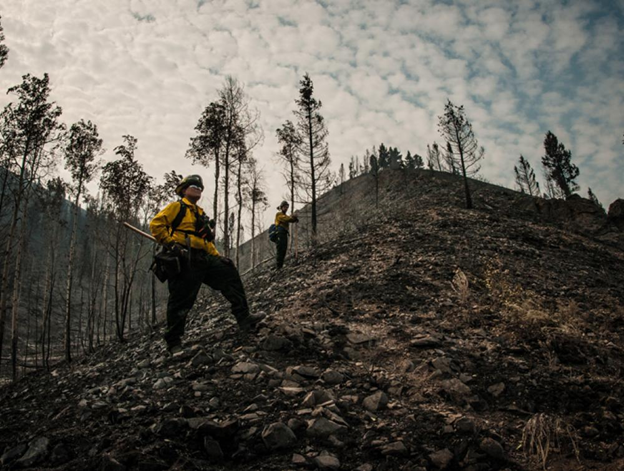Wildfires quickly spread like an inferno consuming any thick and dried-out vegetation along its path. What seems to be an instantaneous burst can overtake thousands of acres of beautiful green landscapes and threaten the homes and lives of many in the parameter. Fires are becoming increasingly frequent and increasingly dangerous. Fueled by high temperatures, high winds, and low humidity, recent fires destroyed Lebanon’s pine forests in Mount Lebanon and other agricultural areas in the South while spreading in all directions. Depending on the vegetation burned, other names can be used for fires like bushfire, grass fire, hill fire, and so on. Generally, fires are initiated in a simple manner: with a quick spark, kindling, and little oxygen, you can end up with an inferno. Sometimes, natural causes like the heat of the summer can cause a fire, but most wildfires are the result of human foolishness.
To better understand how the fire behaves and interacts with its surroundings, we must first investigate its underlying science. The fire triangle is a sign often used to understand the chemical reaction needed for ignition and combustion to happen. For instance, a fire requires fuel to burn, a heat source to increase the temperature of the fuel, and air to feed oxygen to the reaction. To break out a fire, firefighters must eliminate one of the three pillars of the triangle. Another crucial factor that comes to play when studying fires is a material flashpoint. A material flashpoint is the temperature at which the material bursts into flames. In our case, wood is the material we are interested in and the most famous driving force of fires. The flashpoint of wood is 300°C or 572°F. Upon reaching this temperature, wood releases hydrocarbon gases that mix with oxygen in the air, combust and create heat.
In 2021, many countries have recorded unusual wildfire seasons that are believed to be caused by extremely hot weather. The German broadcaster Deutche Welle wrote: “The month of July was the second-hottest ever recorded in Europe (and the third hottest globally).” How can human-induced climate change cause a massive increase in the number of wildfires? A recent study by scientists from UCLA and Lawrence Livermore National Laboratory explains the link between human-caused climate change and the high number of burnt lands in the Western US. The study measured one key climate variable tied to the increased wildfire risk: the vapor pressure deficit. Generally, moisture acts as a fire suppressor because it absorbs heat. Vapor pressure deficit, or VPD, is the maximum amount of moisture that the air can hold minus the current amount of moisture in the air. Usually, large wildfires areas exhibit high vapor pressure deficits related to warm dry air. The study has found that the major increase in vapor pressure deficit between 1979 and 2020 across the western U.S. was likely due to human-caused global warming. Another research conducted at the University of Colorado at Boulder showed that the leading cause of wildfires breakouts in the US is shifting from lighting towards human activity. For example, a campfire that gets out of control can cause a blaze that destroys lands. Other improperly discarded cigarettes are also dangerous. Humans also start intentional fires to create free space for constructions, thus erasing whole green lands.
Fires come in a variety of sizes, frequencies, speeds, and effects. Other factors also come into play when evaluating a wildfire behavior. The fuel load, or the amount of combustive material present for a fire, usually dictates the intensity of the fire. Homes, dry grassy fields, trees, and others constitute combustible material for fires. A big fuel load will eventually lead to a more intense and faster-growing wildfire. Scientists have noticed that by heating the material present in its surroundings, the fires force the moisture to evaporate from the material. Consequently, the dry material will be easier to ignite when the flames reach it. However, tightly packed fuels are harder to burn because they retain more moisture that absorbs heat.
The topography of the land also influences the behavior of fires. Generally, the lay of the land is constant throughout the years, with little or no changes. Slopes are characteristics of lands and dictate the trajectory of wildfires. Fires travel uphill in a much faster fashion than downhill. Usually, the ambient wind flows uphill guiding the fire in the same direction. By doing so, the fire paves its path by preheating the material further up as the smoke and heat rise. When the fire reaches the top hill, it takes a longer time to travel downhill because the material ahead was not preheated. As such, the topography of a land plays a role in the severity of the fire incident.
When battling wildfires, scientists have noticed that the fire suppression methods were causing more harm than good. It is what they call the “fire paradox.” Over time, good intentions of fighting forest fires really backfired with the breakout of more severe fires. The absence of natural wildfires due to harsh fire preventive methods has led to the buildup of plant biomass and tree density. The higher fuel load now available for a spark can feed devastative fires that wouldn’t have existed otherwise. It is why designing new counterfire techniques is crucial to protect ourselves and our surroundings. Our best bet is to cut low-growing bushes, trim out trees and clean the floor of forests. Useful techniques include mechanical trimming that consists of cutting the trees to thinner versions reducing contact among trees to create an isolation space. Another technique is called prescribed burning. By inducing human-controlled fires, the small burning patches that are created can stop the flow of unexpected fires.
All in all, wildfires are a destructive natural force that relies on three pillars: fuel, oxygen, and heat. Delving into the science of wildfires is important for maintaining resources and protecting our lives, properties, and ecosystems. Facing such disasters requires proper knowledge of the dynamics of fires which is primarily the job of firefighters.




